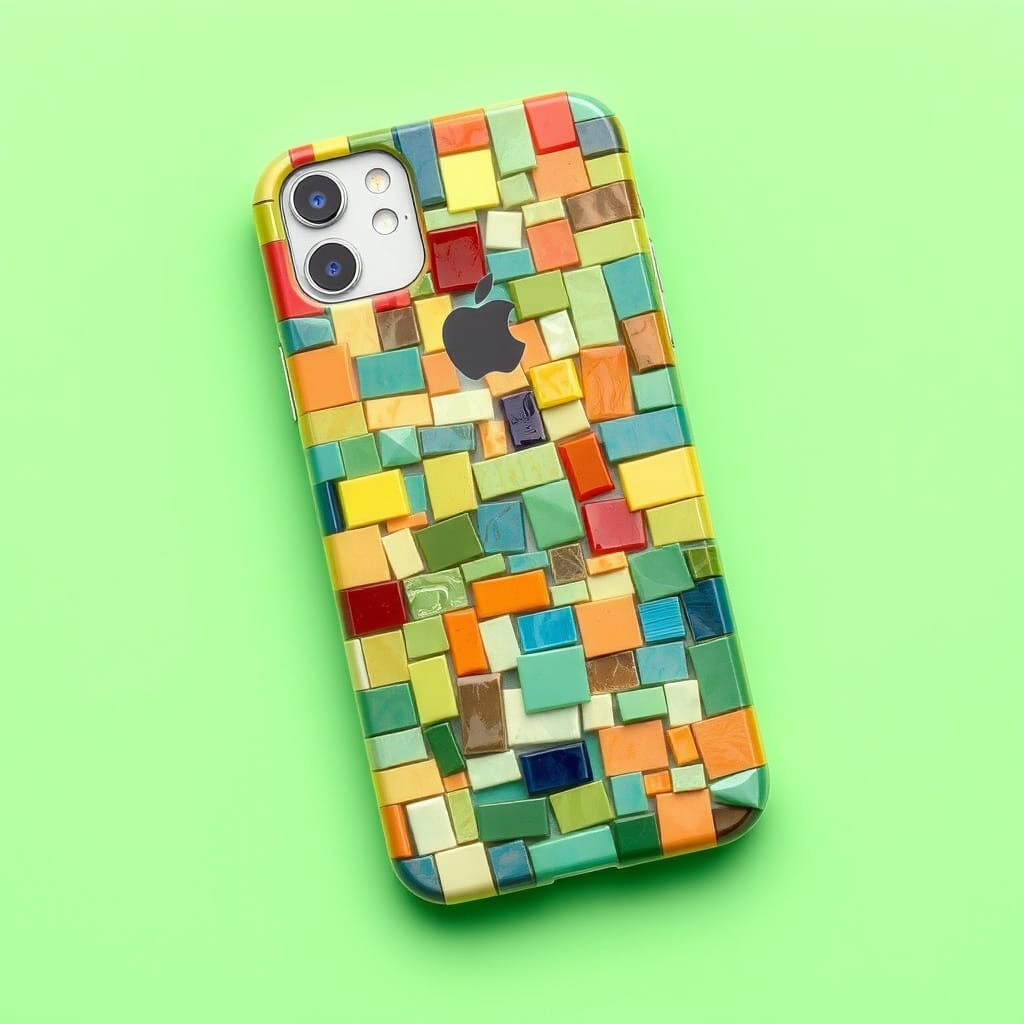In what industry analysts are calling “the most ironic sustainability initiative since coal-powered electric cars,” a prominent Apple accessory maker has announced a new line of iPhone 16 cases made entirely from recycled Lightning cables rendered obsolete by Apple’s switch to USB-C. The cases, scheduled to hit the market later this month, represent what the company calls “the perfect closed-loop ecosystem of technological obsolescence.”
“We’re proud to announce our new uCycle cases, crafted from 100% recycled Lightning cables,” said a product manager while standing in front of a mountain of discarded white cables that reached the ceiling. “When Apple transitioned to USB-C, we saw not a crisis, but an opportunity. An opportunity to take something Apple made obsolete and transform it into something to protect the very device that made it obsolete.”
The cases, which retail for $59.99, are part of a growing trend of tech accessories attempting to minimize environmental impact through creative recycling solutions. However, this particular innovation stands out for its perfect symmetry of problem and solution, as the waste material and the product it’s recycled into serve the exact same ecosystem.
The Great Cable Hoarding Crisis of 2024
According to the company’s environmental impact statement, the average Apple user has accumulated between 4 and 7 Lightning cables since 2012, most of which now sit unused in drawers, boxes, and that one kitchen junk drawer that has somehow become a technological graveyard. A conservative estimate suggests there are approximately 1.2 billion unused Lightning cables currently gathering dust worldwide – enough to (pardon the flat-earthers) circle the Earth 3.5 times if laid end to end.
“People don’t throw these cables away because they feel like they might need them someday,” explained Dr. Eleanor Rigby, Professor of Consumer Psychological Attachment at a prestigious university. “It’s the same psychology that prevents people from throwing away old Nokia phones or that one SCART cable they haven’t needed since 2008. There’s a sense that discarding technology is somehow wasteful, even when the technology has been deliberately rendered obsolete.”
The uCycle case project began when a product designer allegedly discovered a box containing 23 Lightning cables in their desk drawer, none of which worked with their new iPhone 15. Rather than adding to landfill waste, they began experimenting with ways to repurpose the materials.
The Remarkable Engineering Behind Cable-to-Case Transformation
The process of transforming Lightning cables into protective iPhone cases involves what the company describes as “revolutionary materials science.” The cables are first stripped of their outer plastic coating, which is melted down and reformed using proprietary molding techniques. The internal copper wiring is extracted and repurposed into the case’s structure, providing what the company claims is “superior drop protection through metallurgical memory.”
Most impressively, the Lightning connectors themselves are incorporated into the case design as decorative elements, creating what the marketing department has dubbed “a tactile reminder of technological evolution.” Each case features between 8 and 12 Lightning connectors strategically embedded in the back, arranged in artistic patterns that the company describes as “both nostalgic and forward-looking.”
“The challenge was finding a way to maintain the structural integrity of the case while incorporating such diverse materials,” explained a theoretical materials engineer, who reportedly spent 18 months developing the processing technique. “But we’ve achieved something remarkable – a case that’s actually stronger than traditional cases because of the reinforced copper framework. Plus, it has the added benefit of slightly improving your phone’s signal, though we cannot legally claim that as a feature.”
Apple’s Complicated Relationship with Recycling
Apple itself has made significant strides in recycling and environmental sustainability, as evidenced by its 2024 Environmental Progress Report. The company has increased its use of recycled materials across its product line, with iPhone 15 incorporating 75% recycled aluminum in its enclosure and expanded use of recycled cobalt, gold, and steel.
However, critics argue that Apple’s frequent port changes and accessory updates create unnecessary electronic waste, even as the company promotes its environmental credentials. The Lightning port, introduced in 2012 and abandoned in 2023, left millions of cables and accessories instantly outdated, despite being marketed as a port that would last for years.
“Apple has reduced its aluminum-related emissions by 68% since 2015, which is commendable,” noted environmental technology analyst Veronica Chang. “But they’ve also created mountains of e-waste through their ecosystem of proprietary connectors and frequent changes. It’s like someone setting your house on fire and then expecting praise for calling the fire department.”
The uCycle case manufacturer acknowledges this tension, with their website stating: “We’re not creating new waste – we’re just finding creative ways to manage the waste that’s already been created for us.”
The Environmental Impact: Genuine Sustainability or Greenwashing?
While the concept of turning obsolete cables into phone cases is clever, environmental experts remain divided on whether it represents meaningful sustainability or sophisticated greenwashing.
“From a strict materials recovery standpoint, it’s better than mining new resources,” said environmental consultant Jordan River. “But we need to question the underlying system that creates this waste in the first place. Is a slightly thinner phone really worth rendering billions of perfectly functional accessories obsolete?”
According to the manufacturer’s sustainability report, each uCycle case repurposes approximately 3-4 Lightning cables, preventing about 35 grams of e-waste from potentially entering landfills. By comparison, Native Union’s (Re)Classic Case for iPhone 16 claims to be made with 85% recycled materials, equivalent to saving 3 plastic bottles, while dbramante’s Monaco case for the iPhone 16e is made from recycled silicone and plastic materials that keep the equivalent of two plastic bottles out of the environment.
When questioned about the carbon footprint of the processing required to transform cables into cases, the company acknowledged that the manufacturing process does consume energy, but insisted that their facilities run on 100% renewable energy – “except during power outages, when we use diesel generators.”
The Curious Economics of Cable Recycling
Perhaps the most fascinating aspect of the uCycle case is its business model, which relies on consumers paying a premium price for products made from materials they already own but don’t use.
“We’re essentially asking consumers to buy back their own waste at a 2000% markup,” admitted a company executive in what appeared to be an accidental moment of candor during an investor call. “It’s the ultimate circular economy – circular for our profit margins, anyway.”
The company has established collection points at electronics retailers where consumers can deposit their unused Lightning cables in exchange for a 5% discount on a new uCycle case. Early numbers indicate that for every 100 cables collected, approximately 25 cases are sold back to the same consumers who donated the cables in the first place.
“It’s brilliant when you think about it,” said business strategy consultant Maximilian Profit. “They’ve turned waste management into a premium consumer product. Next they’ll be selling bottled air and calling it ‘atmospheric preservation technology.'”
The Psychological Appeal: Why Consumers Love Their Cable Cases
Despite the cynicism from some quarters, early user reviews of the uCycle cases have been surprisingly positive, with many consumers expressing emotional connections to the products.
“There’s something oddly satisfying about knowing my old cables are protecting my new phone,” wrote one reviewer on a tech forum. “It’s like they’ve been reincarnated into something useful again. Plus, I can finally clear out that drawer without feeling guilty.”
Psychologists suggest this emotional response stems from a combination of environmental virtue signaling and technological nostalgia. “People feel good about making supposedly sustainable choices,” explained consumer psychologist Dr. Miranda Chen. “But there’s also a subtle attachment to our technological past. Those Lightning cables represent years of photos, messages, and memories that were transferred through them. Carrying them with you in a new form provides a comforting sense of continuity amid rapid technological change.”
The cases have become particularly popular among the tech industry elite, with several Silicon Valley executives reportedly carrying phones encased in the recycled materials of the very cables their companies helped make obsolete.
The Future of Technological Waste Recycling
Looking ahead, the company has already announced plans to expand their recycled tech accessory line to include products made from other obsolete technologies. Future products will reportedly include laptop stands made from recycled CD-ROMs, wireless charging pads constructed from disassembled floppy disks, and a limited-edition smart speaker built inside the shell of a first-generation iPod.
“The future of sustainability isn’t just about creating less waste – it’s about recognizing that today’s cutting-edge technology is tomorrow’s landfill fodder,” said the company’s Chief Sustainability Officer. “We’re just accelerating that transition while making it fashionable.”
Industry analysts predict that by 2027, the market for products made from recycled tech waste will exceed $2.3 billion annually, with everything from furniture to clothing incorporating elements of discarded technology. Apple itself may be eyeing this market, with rumors suggesting the company is developing its own line of accessories made from recycled Apple products, potentially calling it “Apple Loop.”
Whether this trend represents genuine environmental progress or simply capitalism finding new ways to profit from its own wasteful practices remains an open question. What’s certain is that as technology continues its relentless march forward, the mountain of obsolete devices and accessories will only grow larger, creating ever more opportunities for creative recycling-or creative marketing, depending on your perspective.
Have you accumulated a drawer full of useless Lightning cables and other technological relics? Would you pay $59.99 for a phone case made from your own electronic waste? Share your thoughts in the comments below. And if this article brightened your day, consider making a donation to TechOnion-we accept all forms of payment except Lightning cables, of which we already have enough to build a life-size replica of Tim Cook entirely out of white plastic connectors.
Enjoyed this dose of uncomfortable truth? This article is just one layer of the onion.
My new book, “The Subtle Art of Not Giving a Prompt,” is the definitive survival manual for the AI age. It’s a guide to thriving in a world of intelligent machines by first admitting everything you fear is wrong (and probably your fault).
If you want to stop panicking about AI and start using it as a tool for your own liberation, this is the book you need. Or you can listen to the audiobook for free on YouTube.
>> Get your copy now (eBook & Paperback available) <<





GIPHY App Key not set. Please check settings
One Comment